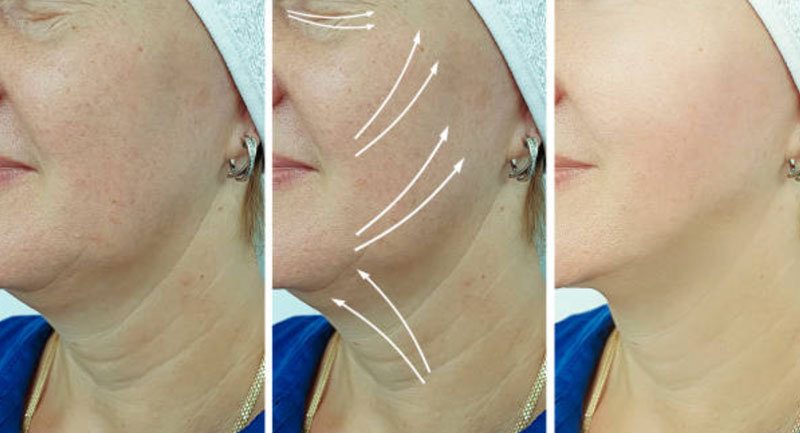Recommendations to Reduce Swelling and Bruising after Getting Facelift Surgery
Facelift surgery, known medically as rhytidectomy, is a procedure that aims to give a more youthful appearance to the face. It reshapes the lower half of the face by removing excess facial skin. While the results can be impressive, the journey to achieving these results involves an important recovery phase. During this time, patients commonly experience bruising and swelling after facelift, which are natural parts of the healing process.
In this blog, Consultant Plastic Surgeon Anthony MacQuillan aims to discuss effective methods to reduce bruising and swelling after facelift surgery.
The Importance of Proper Aftercare Post-Facelift Surgery
When the facial tissues are manipulated during a facelift, the blood vessels running within the tissue planes that are separated are cut leading to bruising (which is literally blood within the tissues). The body’s natural response to injury causes swelling. This is known as inflammation. The inflammatory process is an important mechanism as it is resulting in increased blood flow to an injured area (bringing in more nutrients and oxygen to the damaged tissue) and makes the smallest blood vessels (the capillaries) leaky (this is what results in swelling as water leaks out of the blood vessels into the spaces between the individual cells of the tissue). The increased leakiness is designed to allow cells that circulate within the blood stream the move out of the circulation and into the area of injury by squeezing through the gaps in the capillary walls.
Bruising often appears within the first 48 hours post-surgery and can vary in intensity. It starts as red or purple and gradually fades to yellow or green as it heals. The extent and duration of bruising depend on several factors, including the individual’s healing ability, the extent of the surgery, and how carefully the patient follows post-operative care instructions. Swelling is most pronounced in the first few days following surgery. It is the result of the body sending more blood and fluids to the area to aid in the healing process. While it can be quite noticeable, remember that it’s a temporary and a normal part of recovery.
Proper aftercare following a facelift is critical to minimise bruising and swelling and to ensure the best possible outcome. The actions you take in the days and weeks following your surgery can significantly affect your recovery speed and the quality of your results.
Post-operative care involves following Anthony’s instructions closely, which include guidelines on how to care for your incisions, medications to take to help with the healing process and reduce the risk of infection, and tips on how to reduce swelling and bruising after facelift. It also includes advice on when you can return to normal activities and what activities to avoid during the recovery process.
Anthony’s instructions will be tailored to your specific situation, considering the details of your surgery and your overall health. It’s essential to follow these instructions carefully and to keep all follow-up appointments so that he can monitor your healing and intervene if necessary to address any complications.

Immediate Post-Operative Care
Facelift surgery is a complex procedure, and the first 24 hours after the surgery are crucial for a successful recovery. During this period, patients need to follow specific care routines to ensure optimal healing and to minimise the risk of complications.
First 24 Hours – What to Expect
In the immediate hours following a facelift, it’s normal to experience discomfort, swelling, and bruising. The extent of these symptoms can vary depending on the individual’s sensitivity, the complexity of the procedure, and the body’s response to surgery.
- Pain and Discomfort: Mild to moderate pain is common, but Anthony will provide pain relief medication to manage it. It’s important to take these medications as prescribed to maintain comfort
- Swelling: Swelling is most pronounced in the first 24 hours. It’s your body’s natural response to surgery and part of the healing process (see above!)
- Bruising: Bruising will start to appear and may increase in the first few days. It’s a sign that your body is healing
- Nausea: Some people experience nausea, particularly as a reaction to anaesthesia or pain medication
- Tightness and Numbness: A sensation of tightness especially in the neck and when trying to open your mouth is very common especially whilst the external quilting sutures I use to help reduce the risk of bleeding and to reduce the extent of swelling are still in situ (see my upcoming blog on this subject!). You will have numbness around the operated areas (especially over the front and sides of the neck and the sides of the face).
Essential Care Tips for the First Day
- Rest and Monitoring: It’s essential to rest during the first 24 hours. You should have someone to help you and monitor your recovery, as you’ll likely be groggy from the anaesthesia (most patients choose to stay the first night in the hospital where the nursing staff will undertake this role).
- Head Elevation: Keep your head elevated above your heart level to reduce swelling. Use pillows to prop up your head when lying down
- Hydration and Diet: Stay hydrated by drinking plenty of water. Stick to light, easy-to-digest foods to avoid nausea. Coca-Cola (not diet Coke) is an excellent way to get fluid, sugar and electrolytes on board in the first 12 hours following surgery – but it is best served cold!
- Ice Packs: Apply ice packs or cold compresses to reduce swelling but be sure to wrap them in a cloth to avoid direct contact with the skin. If you are staying your first night in the hospital you will have Hilotherm machine (a cooling device that circulates water through a mask that you wear at a constant 17°C) to help keep you comfortable and reduce swelling
- Medication Compliance: Take all prescribed medications, including antibiotics and painkillers, according to your surgeon’s instructions
- Avoid Strenuous Activities: Avoid any strenuous activities, bending, lifting, or straining, as these can increase swelling or bleeding
- Wound Care: Follow Anthony’s instructions for wound care, which may include cleaning the incision sites and applying ointments. If you have quilting sutures, these will need to be cleaned with gauze and saline twice daily whilst the sutures are in place (we will supply you with these). The incisions themselves will have glue over them to keep them sealed whilst any hairline incisions usually have staples in them. These can be washed but you will need to avoid rubbing shampoo directly onto the incisions and it is best to use a really mild shampoo – Johnson & Johnson No More Tears is a very good bet! You will probably want to wash your hair as inevitably there will be some residual blood in it from the operation (although we do wash your hair at the end of the procedure) – be careful though when having a shower to limit the water temperature to 38°C (the point on a mixer tap where you have to press the button to make the water hotter) as the skin that has been operated on has a decreased resistance to thermal injury and above this temperature it would be easy to burn the cheeks and neck, especially as the skin is likely to be numb.
Managing Swelling after Facelift
Swelling after a facelift is a normal part of the healing process. However, how you manage it can impact both your comfort during recovery and the overall outcome of your surgery. Effective management of swelling can also help to reduce the risk of complications.
Elevating Your Head
Elevation plays a crucial role in reducing post-surgical swelling. By keeping your head elevated, you are using gravity to your advantage, helping to prevent excessive fluid build-up in the facial area.
- Posture: For the first few weeks, sleep with your head elevated at least 30 degrees. You can use a wedge pillow or stack several pillows to achieve the right angle
- Consistency: Maintain this elevated position during sleep and as much as possible during the day. Even when sitting, try to keep your head above heart level
Cold Compresses
Cold compresses are effective in reducing swelling, but they must be used correctly to avoid causing harm.
- Duration: Apply cold compresses for about 15-20 minutes at a time. Doing this every hour for the first 48 hours can be particularly helpful
- Technique: Always wrap the cold source in a cloth or use a commercial cold pack designed for injury treatment. Never apply ice directly to the skin, as this can cause frostbite and damage the delicate post-operative tissues
- Hilotherm: You can rent a cooling machine (https://hilotherm.co.uk/rent-a-device__trashed/) for the first-week post operation. We can supply you with the mask so you will need to rent the machine only
Medications and Supplements to Reduce Swelling
Several medications and supplements can be beneficial in managing post-surgical swelling:
- Prescribed Medications: Follow Anthony’s instructions regarding any prescribed anti-inflammatory medications
- Arnica Montana: This natural supplement may be recommended to help reduce bruising and swelling. It is not to be taken before surgery (as it can increase the tendency to bleed during the operation) but is fine to use after the procedure
- Avoid Certain Medications: Some over-the-counter medications and supplements can increase swelling or bleeding. These include aspirin, ibuprofen, and certain herbal (particularly turmeric) supplements. Always consult with Anthony before taking any new medication or supplement
- Hydration: Drinking plenty of water can help combat dehydration and the feeling of nausea. It is important not to overdo water consumption (without taking the equivalent amount of electrolytes) as this can cause swelling which if significant can actually impede healing! The normal person needs 3L of fluid a day (which can be taken in almost any form so it does not have to be straight-up water). Sports recovery drinks have both sugar and electrolytes in and as mentioned above we get patients to drink regular Coke (cold) immediately following the surgery as the sugar, electrolytes and fluid are an immediate benefit and the fizzy factor helps the stomach empty, avoiding nausea and vomiting (the gas bubbles actually encourage the pyloric sphincter of the stomach – the gateway into the gut itself – to open encouraging the stomach to empty and so reducing any sensation of nausea)
- Diet: Eating a balanced diet rich in carbohydrates, protein, vitamins and minerals can support the body’s natural healing processes. Foods high in sodium should be avoided, as they can exacerbate swelling
Minimising Bruising after Facelift Surgery
Bruising is a common and natural response to facelift surgery. While it is an inevitable part of the healing process, there are several strategies that can be employed to minimise its appearance and duration.
Understanding the Bruising Process
Bruising occurs when small blood vessels are damaged during surgery, causing blood to leak into the surrounding tissues. The body then breaks down this blood, leading to a change in bruise colour from black-blue to green-yellow before it fully disappears.
- Phases of Bruising: Initially, bruises are typically red or purple. Over time, they change to yellow or green as they heal
- Individual Differences: The extent of bruising varies from person to person. Factors such as age, skin type, and overall health can influence the severity and duration of bruising
Recommended Topical Treatments
Several topical treatments can be effective in reducing the appearance of bruises:
- Arnica Gel or Cream: Arnica is known for its anti-inflammatory properties and can be applied topically to bruised areas to speed up healing
- Vitamin K Cream: This can help reduce the visibility of bruises by promoting blood clotting and healing
- Gentle Massage: With your plastic surgeon’s approval, gentle massage around the bruised areas can improve blood flow and facilitate healing. However, be very cautious and gentle to avoid any additional trauma to the area
Dietary Adjustments to Help Heal Bruises
What you eat can also impact how quickly your bruises heal:
- Foods Rich in Vitamin C and K: These vitamins are crucial for healing and repairing the skin. Citrus fruits, leafy greens, and berries are excellent sources
- Pineapple and Papaya: These fruits contain bromelain and papain, enzymes that can help reduce bruising and swelling
- Hydration: Drinking plenty of water (but not too much see above!) helps to flush out toxins and can speed up the healing process
- Avoid Alcohol and Salt: Alcohol can increase swelling and delay healing, while salt can exacerbate water retention and swelling

Long-Term Care and Recovery after Facelift
Recovery from a facelift is a gradual process that requires careful attention over several weeks. Long-term care is essential for ensuring a successful recovery and achieving the desired aesthetic results.
Sleep Position and Its Impact on Recovery
Sleeping position plays a significant role in the recovery process following a facelift. Proper positioning helps to reduce swelling and prevents undue pressure on the healing tissues.
- Elevation: Continue to sleep with your head elevated for several weeks post-surgery. This helps to reduce ongoing swelling and promotes faster healing
- Avoiding Pressure: Try to sleep on your back instead of on your sides or stomach. Pressure on the sides of your face can cause asymmetrical swelling and may affect the final outcome
Activities to Avoid During Recovery
Certain activities should be avoided during the recovery phase to ensure optimal healing:
- Intense Exercise: Avoid heavy lifting, high-impact sports, and strenuous workouts for at least 4-6 weeks post-surgery, as these activities can increase swelling and bleeding
- Sun Exposure: Protect your skin from the sun. UV rays can worsen swelling, cause scars to darken, and slow down the healing process. Use sunscreen and wear protective clothing when outdoors
- Smoking and Alcohol: Smoking can significantly impede healing by reducing blood flow to the skin and can lead to skin death – it is essential that you do not smoke for the first 6 weeks following surgery. Alcohol can increase swelling and bruising. Both should be avoided during the recovery period
When to Resume Normal Activities
The timeline for resuming normal activities varies based on the individual’s healing process and the complexity of the surgery:
- Light Activities: Most patients can resume light, day-to-day activities within 2 weeks after surgery. However, any activity that could result in a blow to the face should be avoided
- Return to Work: Depending on the nature of your job, you may be able to return to work within 2-3 weeks. Jobs that require physical exertion or are public-facing may require a longer recovery period
- Final Results: Remember that it can take several months for the final results of your facelift to become apparent. Patience is key during this time
FAQs about How to Reduce Bruising and Swelling after Facelift

How long does it typically take for bruising and swelling to subside after a facelift?
- While individual experiences vary, most people see significant improvement in bruising and swelling within 2 to 3 weeks post-surgery. Swelling will persist for several months as the tissues fully heal.
Are there any specific facial exercises I should do or avoid after a facelift to reduce swelling?
- Generally, it’s advised to avoid any facial exercises immediately after surgery as they can exacerbate swelling. Anthony may recommend gentle facial movements or massages at a certain stage in your recovery to aid in healing.
How can I ensure the fastest recovery with minimal bruising and swelling?
- The key to a fast recovery is to follow Anthony’s post-operative instructions closely, maintain a healthy diet, stay hydrated, and avoid activities that can strain your facial muscles or increase blood pressure.
Are there any specific foods I should eat or avoid to help with bruising and swelling?
- Foods rich in antioxidants, like fruits and vegetables, can aid in healing. It’s also advisable to avoid salty foods as they can contribute to fluid retention and swelling.
Can lymphatic massage help reduce swelling after a facelift?
- Lymphatic massage can be beneficial for some patients, as it helps to reduce fluid build-up. However, this should only be done under the guidance of a trained professional and with your plastic surgeon’s approval.
Further reading about Facelift with Consultant Plastic Surgeon Anthony MacQuillan
- Read more about Top Tips to Sleep Better After Facelift Surgery
- Read more about Visible Effects of Ageing That Can Be Improved with a Facelift



